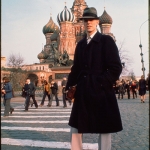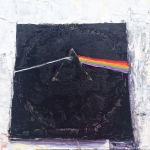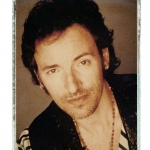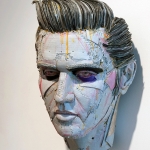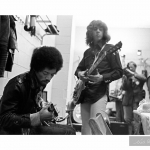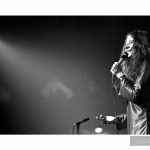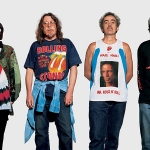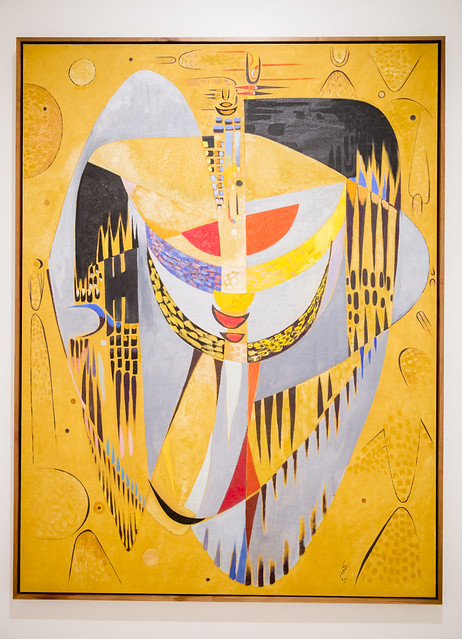Past Exhibitions in Ketchum 2014
Under the Influence of Rock & Roll
November 21, 2014 – January 30, 2015
A BIG IDEA project of the Sun Valley Center for the Arts
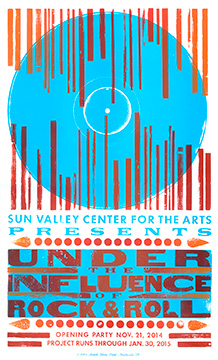 The influence of rock & roll on American culture is indisputable. By the 1960s it had transcended the realm of music and had begun to shape an entire generation’s understanding of the world around them. For many fans, rock & roll offered an identity: it guided how they spent their money and time, how they dressed and wore their hair and who their friends were. Under the Influence of Rock & Roll speaks to how rock, born out of counter-culture rebellion, has permeated the very fabric of our country and our collective memories, from television and film to fashion and design to political and social history.
The influence of rock & roll on American culture is indisputable. By the 1960s it had transcended the realm of music and had begun to shape an entire generation’s understanding of the world around them. For many fans, rock & roll offered an identity: it guided how they spent their money and time, how they dressed and wore their hair and who their friends were. Under the Influence of Rock & Roll speaks to how rock, born out of counter-culture rebellion, has permeated the very fabric of our country and our collective memories, from television and film to fashion and design to political and social history.
In crafting this BIG IDEA project about the history of rock & roll and its continuing influence, we’ve drawn on photography, painting, sculpture, records, magazines and posters from local collections and beyond.
On view are photographs by Edie Baskin, who spent 20 years as the photographer for Saturday Night Live; Andrew Kent and Ethan Russell’s photos of some of the most influential names in rock & roll; Scott Fife’s sculptures of rock icons; Gideon Bok’s paintings of album covers; Henry Hargreaves and Caitlin Levin’s photography exploring band rider requirements; James Mollison’s life-sized images of Rolling Stones fans; and contemporary and historic show posters from Hatch Show Print, Dick Dahlgren, Gary Houston, Ron Jasin, Mike King, Jason Munn, Andrew Saeger, Silent Giants, Dan Stiles, John Vogl and Neal Williams.
Photo Gallery
Exhibition Video
Visual Arts Events
Gallery Walks, FREE at The Center, Ketchum
- Saturday, Dec 27, 5–7pm
Start your Gallery Walk at The Center!
Evening Exhibition Tours, FREE at The Center, Ketchum
- Thursday, Dec 4, 5:30pm
- Thursday, Jan 8, 5:30pm
Enjoy a glass of wine as you tour the exhibition with The Center’s curators and gallery guides. Favor de llamar al Centro de las Artes para arreglar visitas guiadas en español.
Forests, Foraging and Fires
August 23 – November 12, 2014
A BIG IDEA project of the Sun Valley Center for the Arts
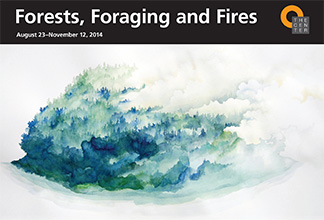 Forests, Foraging and Fires offers our community the opportunity to participate in an in-depth conversation about our relationship to one of our most significant natural resources: the forest. The northwestern United States has long looked to its forests for sustenance, renewal and recreation. Our forests not only provide us with trees that heat and shelter us, but they are also a place we look to for spiritual and physical renewal. They are where we recreate and where we retreat. In the Wood River Valley, our forests are our lifeblood; their majestic beauty attracts people to our resort
Forests, Foraging and Fires offers our community the opportunity to participate in an in-depth conversation about our relationship to one of our most significant natural resources: the forest. The northwestern United States has long looked to its forests for sustenance, renewal and recreation. Our forests not only provide us with trees that heat and shelter us, but they are also a place we look to for spiritual and physical renewal. They are where we recreate and where we retreat. In the Wood River Valley, our forests are our lifeblood; their majestic beauty attracts people to our resort
community.
The forest is a place of mystery and magic, too—the setting for many a fairy tale. For Shakespeare and other authors and playwrights, the forest is a place of transformation.
And it’s a place of extraction, providing much more than wood. Today in addition to game hunters, people are going into the forest to seek out its wealth, foraging for everything from mushrooms to edible greens to poultices for healing.
Simultaneously, the forest is becoming a significant threat as federal fire suppression policy coupled with years of drought has created an explosive tinderbox that poses a danger to our homes and communities.
This project asks not only what we take from our forests, but what we need to do to sustain and nurture them.
Exhibition Video
Visual Arts Events
Gallery Walks, FREE at The Center, Ketchum
- Friday, Aug 29, 5–7pm
Start your Gallery Walk at The Center!
Evening Exhibition Tours, FREE at The Center, Ketchum
- Thursday, Sept 4, 5:30pm
- Thursday, Oct 16, 5:30pm
- Thursday, Nov 6, 5:30pm
Enjoy a glass of wine as you tour the exhibition with The Center’s curators and gallery guides. Favor de llamar al Centro de las Artes para arreglar visitas guiadas en español.
Western Light, Ecstatic Landscapes
June 6 – August 16, 2014
A Visual Arts Exhibition of the Sun Valley Center for the Arts
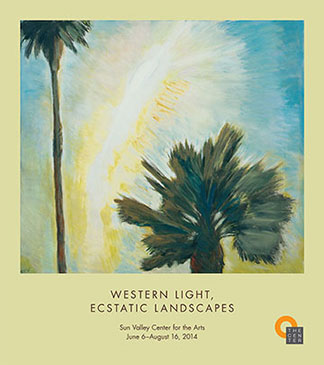 In 1993 art historian Paul Karlstrom asked painter Lee Mullican about the impact of the Southwest on his painting. Mullican—who was born in Oklahoma, had lived for decades in California and was then spending much of his time in Taos, New Mexico—answered, “A lot of it has to do with nature, and a lot of it has to do with just an atmosphere that exists there…it’s a way of living with…something as simple as open skies. So that all during the day you have this great open three-hundred-and-sixty-degree sky, within which color and light and cloud and rainbow and rain…cannot help but be a spiritual influence.”
In 1993 art historian Paul Karlstrom asked painter Lee Mullican about the impact of the Southwest on his painting. Mullican—who was born in Oklahoma, had lived for decades in California and was then spending much of his time in Taos, New Mexico—answered, “A lot of it has to do with nature, and a lot of it has to do with just an atmosphere that exists there…it’s a way of living with…something as simple as open skies. So that all during the day you have this great open three-hundred-and-sixty-degree sky, within which color and light and cloud and rainbow and rain…cannot help but be a spiritual influence.”
Those of us who have spent time in the American West understand the spiritual influence of which Mullican speaks. The peculiar quality of Western light has exerted a magnetic pull on generations of artists who have tried to capture it on canvas or paper. While the official history of American art tends to focus on New York, there was an impressive migration of artists westward during the mid-20th century. Western Light, Ecstatic Landscapes presents artworks made between the 1930s and 1980s that endow the landscape of the American West with a spiritual quality. Few of the paintings in this exhibition look like traditional landscapes; almost all, however, start with the idea of the land as the basis for works that transcend the material in search of the metaphysical.
The exhibition consists of three bodies of work: paintings by artists associated with the Transcendental Painting Group, based in New Mexico in the late 1930s and early 1940s; work by the artists of the Dynaton, a movement that emerged out of Surrealism in Northern California in the late 1940s and early 1950s; and paintings by Frederick S. Wight, whose career as a painter flourished in the 1970s and 1980s, only after his retirement from a long career as a curator and museum director at UCLA. The paintings in the exhibition range widely in terms of aesthetic. Yet the work is connected by a shared desire to convey spiritual or metaphysical ideas grounded in the light and landscape of the American West.
Exhibition Video
Visual Arts Events
Gallery Walks, FREE at The Center, Ketchum
- Friday, July 11, 5–7pm
- Friday, Aug 8, 5–7pm
Start your Gallery Walk at The Center!
Evening Exhibition Tours, FREE at The Center, Ketchum
- Thursday, July 10, 5:30pm
- Thursday, Aug 14, 5:30pm
Enjoy a glass of wine as you tour the exhibition with The Center’s curators and gallery guides. Favor de llamar al Centro de las Artes para arreglar visitas guiadas en español.
Photo Gallery
Creativity at Work
Feb 21 – May 24, 2014
A BIG IDEA project of the Sun Valley Center for the Arts
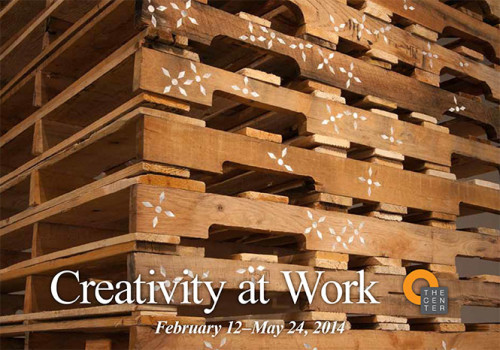 In 2011 and again in 2012, the staff at the professional networking site LinkedIn surveyed its members and found the number one word they used to describe themselves was “creative.” While bloggers at LinkedIn described the word as overused, perhaps it in fact reflects a shift in our culture’s attitudes and values regarding work.
In 2011 and again in 2012, the staff at the professional networking site LinkedIn surveyed its members and found the number one word they used to describe themselves was “creative.” While bloggers at LinkedIn described the word as overused, perhaps it in fact reflects a shift in our culture’s attitudes and values regarding work.
We associate the word creativity with the arts. But, obviously, workers across the economic spectrum find that creativity is an essential part of what they do. How do different kinds of workers, from musicians to software developers to farmers, integrate creativity into their work? And how has technology boosted (or stifled) our ability to think and perform creatively?
Author and urban studies specialist Richard Florida argues that creativity must be the fundamental driver of our economy. Businesses that prioritize innovation have become the nation’s economic leaders, and, as science writer Jonah Lehrer points out, some corporations are using science to create environments specifically designed to trigger creativity.
Lehrer has written that moments of innovation often seem to occur out of the blue, as a flash of insight. But, he explains, these moments usually follow a considerable amount of work, and precede revisions and reiterations. Creativity and hard work are inextricably linked.
This multidisciplinary project considers that link—the connection between work and creativity—and its impact on the American workplace through workshops, theatre, lectures, films and a visual arts exhibition.
Photo Gallery
Exhibition Video
Visual Arts
Art is inherently creative. But it’s also hard work. And artists need to make a living. This exhibition considers the idea of “work” from various perspectives: the places work is done, the collaborative nature of creative work, the skill and craft involved in making objects, and the economics of work.
Meggan Gould’s Workspace photos depict places where creative work takes place. Some of these are places we associate with creativity: an artist’s studio, a commercial kitchen, a classroom. Others are less expected: the worktable of a glass eyeball painter, a boatyard, the studio of a duck decoy maker.
Tracy Linder grew up on a family farm and now lives on the prairie of south central Montana. Her sculptural installations consider the human relationship to the land and to our food through agriculture and agribusiness. On display in The Center’s project room is Conversations with the Land, large panels made from animal collagen that feature photographic images of family farmers at work.
Internationally known artist Allan McCollum has been working for several years on The Shapes Project, a system to design a unique two-dimensional shape for every person on the planet. Using a modular set of components, McCollum creates each shape by hand in Adobe Illustrator. The system is organized to create up to 31,000,000,000 individual shapes, and McCollum has been producing them in groups—sometimes working with craftspeople to translate his shapes into different kinds of utilitarian or decorative objects. For Shapes from Maine, for example, he worked with four small businesses based in Maine to produce cookie cutters, Christmas tree ornaments, silhouettes and rubber stamps. For this exhibition, The Center has been working with McCollum to create Shapes from Idaho. Inspired by the wooden signage that surrounds us in the Sawtooth National Recreational Area and other public lands, Bellevue-based sign maker Jason Georgiades has produced 144 wooden signs featuring sandblasted shapes that McCollum created using his system. Installed together, the signs unite a number of ideas at the heart of our project: the connection between creativity and craft, the systems that underlie creativity and the collaborative quality of creative work.
Danica Phelps has devoted much of her career to carefully tracking the financial side of her life as an artist. For this exhibition, she is creating a series of drawings that are part of her ongoing project Income’s Outcome, a meticulous record of the money she receives from selling artwork and her expenses. Drawings of red and green stripes represent money coming into and out of her household and hang alongside simple, elegant line drawings of things she’s purchased with her earnings.
Yumi Janairo Roth is interested in work that often gets overlooked, including construction and shipping. She takes utilitarian objects associated with these fields and uses other materials to elevate them, making them precious: a chain link fence made of sterling silver; shipping pallets inlaid with mother of pearl.
Working with non-traditional materials (paper and Tyvek envelopes that once enclosed bills, bank statements and paychecks), Stephen Sollins has created a series of traditionally patterned quilts, using a form historically considered “women’s work” to consider the connection between labor and craft as well as the financial side of creative work.
Visual Arts Events
Gallery Walks, FREE at The Center, Ketchum
- Friday, Mar 14, 5–7pm
- Saturday, May 24, 5–7pm
Start your Gallery Walk at The Center!
Evening Exhibition Tours, FREE at The Center, Ketchum
- Thursday, Feb 27, 5:30pm
- Thursday, Mar 20, 5:30pm
- Thursday, Apr 10, 5:30pm
Enjoy a glass of wine as you tour the exhibition with The Center’s curators and gallery guides. Favor de llamar al Centro de las Artes para arreglar visitas guiadas en español.
Wish You Were Here
Dec 13, 2013 – Feb 15, 2014
A BIG IDEA project of the Sun Valley Center for the Arts
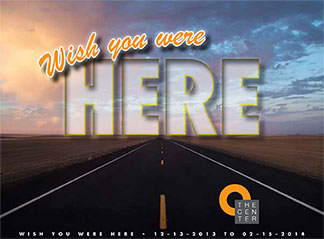 The road trip has been around for centuries. First-century Roman aristocrats traveled around the Mediterranean visiting sites that even then were considered ancient wonders. During the Middle Ages, pilgrims booked “all inclusive” package tours of the Holy Land that departed from Venice. 17th- and 18th-century young British men embarked on the Grand Tour through Western Europe.
The road trip has been around for centuries. First-century Roman aristocrats traveled around the Mediterranean visiting sites that even then were considered ancient wonders. During the Middle Ages, pilgrims booked “all inclusive” package tours of the Holy Land that departed from Venice. 17th- and 18th-century young British men embarked on the Grand Tour through Western Europe.
Until recently, leisure travel was restricted to the upper classes. The birth of the tourism industry as we know it emerged in the 19th century with the development of railroads and steamships—relatively easy, inexpensive means of travel.
In the United States, railroads fed a boom in tourism and led to the development of destination resorts like Sun Valley. But U.S. tourism is probably best defined by the road trip, the classic American vacation that has sent countless travelers out onto highways to visit National Parks, historic sites and cultural destinations. Road trips are part of the fabric of American culture, the basis for works ranging from Jack Kerouac’s On the Road to National Lampoon’s Family Vacation. Americans live in a country with huge regional variation—the cross-country road trip gives them the opportunity to get to know it in a deeper way, to reaffirm their identities as Americans.
While road trippers may set out with specific goals for their trips, organizing them around ball parks or battlefields, most of us plan our itineraries the same way the ancient Romans did. We tend to visit the same places and take the same photos.
As they have always been, road trips continue to be educational experiences. We buy souvenirs and take snapshots in order to take a little bit of our journey home with us, to literally help us remember the places we’ve been. We send postcards (or update our Facebook status) in order to share our travels (and perhaps impress our friends with them). We travel to broaden our horizons but ultimately, so that we can return home knowing a little bit more about ourselves and our place in the world.
Wish You Were Here has been generously sponsored by The Paul G. Allen Family Foundation.
Additional support for student-based educational projects has been generously provided by Cox Communications and the Richard K. and Shirley S. Hemingway Foundation.
Photo Gallery
Exhibition Video
VISUAL ARTS
A visual arts exhibition in Ketchum will feature:
- Lightboxes and ceramic plates from Elliot Anderson’s Average Landscapes project;
- Photographs from Reconstructing the View by Mark Klett and Byron Wolfe;
- Matt McCormick’s The Great Northwest, an installation of photographs, a scrapbook and a documentary film (see more at: www.thegreatnorthwest.org
Matt McCormick’s installation The Great Northwest has been generously sponsored by Sarah & David Woodward;- Photographs from Roger Minick’s Sightseer series;
- A series of postcard-sized paintings artist Cedra Wood made after a visit to Sun Valley this fall;
- Karla Wozniak’s paintings and drawings of the strips of motels, restaurants and chain stores that line interstate highway exits;
- A selection of photographs and memorabilia highlighting the role of Union Pacific and Santa Fe railroads in expanding tourism in the West.
Visual Arts Events
Gallery Walks, FREE at The Center, Ketchum
- Friday, Dec 27, 5–7pm
We’ll be screening Amanda Hamilton’s short film It Happened in Sun Valley, an entertaining look at Sun Valley as a tourist destination through the eyes of Hollywood.- Friday, Feb 14, 5–7pm
We’ll be screening Amanda Hamilton’s short film It Happened in Sun Valley, an entertaining look at Sun Valley as a tourist destination through the eyes of Hollywood.
Start your Gallery Walk at The Center!
Evening Exhibition Tours, FREE at The Center, Ketchum
- Thursday, Jan 16, 5:30pm
Artist Elliot Anderson will be lecturing at 6pm following the Jan 16 tour. Elliot Anderson, whose Average Landscapes are part of the exhibition, will address the link between American landscape painting and American tourism. Hudson River School artists painted images of American wonders that drew tourists into the wild. Anderson’s talk will place his digitally fabricated photographs within this historic context, discussing the way his Average Landscapes reimagine the American desire for the sublime.- Thursday, Feb 13, 5:30pm
The Community Library’s Regional History Librarian Sandra Hofferber will share the history of the railroad in Sun Valley at the Feb 13 tour.
Enjoy a glass of wine as you tour the exhibition with The Center’s curators and gallery guides. Favor de llamar al Centro de las Artes para arreglar visitas guiadas en español.



